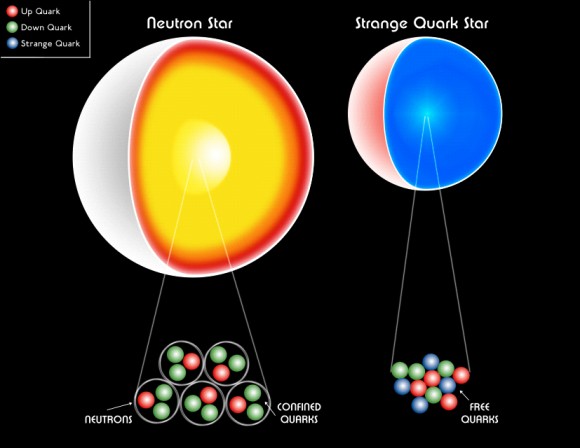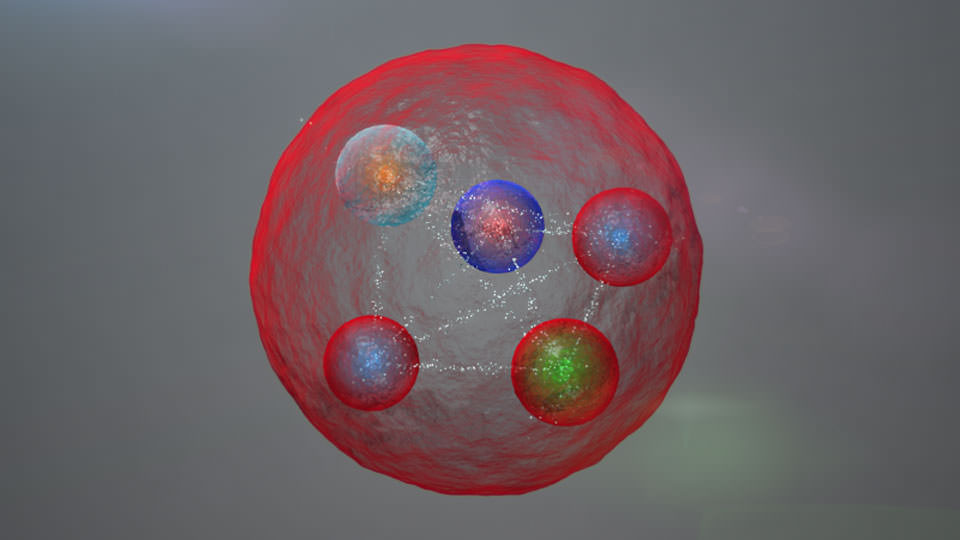“Three quarks for Muster Mark!,” wrote James Joyce in his labyrinthine fable, Finnegan’s Wake. By now, you may have heard this quote – the short, nonsensical sentence that eventually gave the name “quark” to the Universe’s (as-yet-unsurpassed) most fundamental building blocks. Today’s physicists believe that they understand the basics of how quarks combine; three join up to form baryons (everyday particles like the proton and neutron), while two – a quark and an antiquark – stick together to form more exotic, less stable varieties called mesons. Rare four-quark partnerships are called tetraquarks. And five quarks bound in a delicate dance? Naturally, that would be a pentaquark. And the pentaquark, until recently a mere figment of physics lore, has now been detected at the LHC!
So what’s the big deal? Far from just being a fun word to say five-times-fast, the pentaquark may unlock vital new information about the strong nuclear force. These revelations could ultimately change the way we think about our superbly dense friend, the neutron star – and, indeed, the nature of familiar matter itself.
Physicists know of six types of quarks, which are ordered by weight. The lightest of the six are the up and down quarks, which make up the most familiar everyday baryons (two ups and a down in the proton, and two downs and an up in the neutron). The next heaviest are the charm and strange quarks, followed by the top and bottom quarks. And why stop there? In addition, each of the six quarks has a corresponding anti-particle, or antiquark.

An important attribute of both quarks and their anti-particle counterparts is something called “color.” Of course, quarks do not have color in the same way that you might call an apple “red” or the ocean “blue”; rather, this property is a metaphorical way of communicating one of the essential laws of subatomic physics – that quark-containing particles (called hadrons) always carry a neutral color charge.
For instance, the three components of a proton must include one red quark, one green quark, and one blue quark. These three “colors” add up to a neutral particle in the same way that red, green, and blue light combine to create a white glow. Similar laws are in place for the quark and antiquark that make up a meson: their respective colors must be exactly opposite. A red quark will only combine with an anti-red (or cyan) antiquark, and so on.
The pentaquark, too, must have a neutral color charge. Imagine a proton and a meson (specifically, a type called a J/psi meson) bound together – a red, a blue, and a green quark in one corner, and a color-neutral quark-antiquark pair in the other – for a grand total of four quarks and one antiquark, all colors of which neatly cancel each other out.
Physicists are not sure whether the pentaquark is created by this type of segregated arrangement or whether all five quarks are bound together directly; either way, like all hadrons, the pentaquark is kept in check by that titan of fundamental dynamics, the strong nuclear force.
The strong nuclear force, as its name implies, is the unspeakably robust force that glues together the components of every atomic nucleus: protons and neutrons and, more crucially, their own constituent quarks. The strong force is so tenacious that “free quarks” have never been observed; they are all confined far too tightly within their parent baryons.
But there is one place in the Universe where quarks may exist in and of themselves, in a kind of meta-nuclear state: in an extraordinarily dense type of neutron star. In a typical neutron star, the gravitational pressure is so tremendous that protons and electrons cease to be. Their energies and charges melt together, leaving nothing but a snug mass of neutrons.
Physicists have conjectured that, at extreme densities, in the most compact of stars, adjacent neutrons within the core may even themselves disintegrate into a jumble of constituent parts.
The neutron star… would become a quark star.

Scientists believe that understanding the physics of the pentaquark may shed light on the way the strong nuclear force operates under such extreme conditions – not only in such overly dense neutron stars, but perhaps even in the first fractions of a second following the Big Bang. Further analysis should also help physicists refine their understanding of the ways that quarks can and cannot combine.
The data that gave rise to this discovery – a whopping 9-sigma result! – came out of the LHC’s first run (2010-2013). With the supercollider now operating at double its original energy capacity, physicists should have no problem unraveling the mysteries of the pentaquark even further.
A preprint of the pentaquark discovery, which has been submitted to the journal Physical Review Letters, can be found here.


